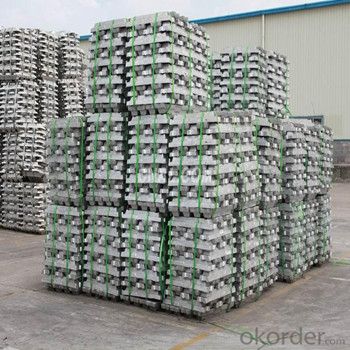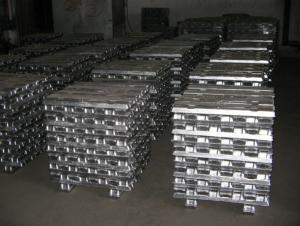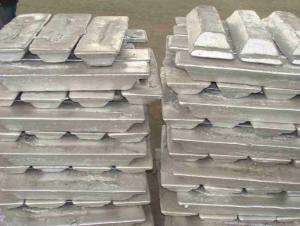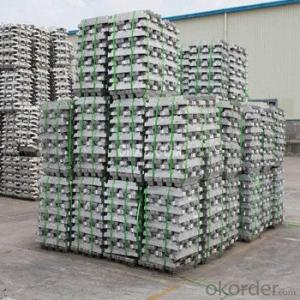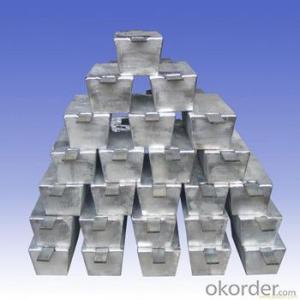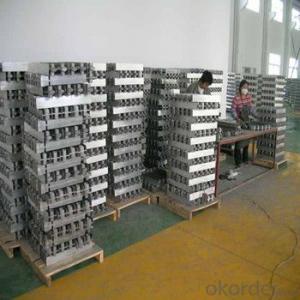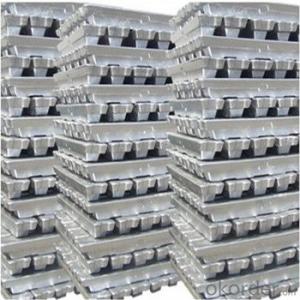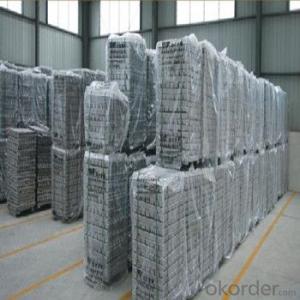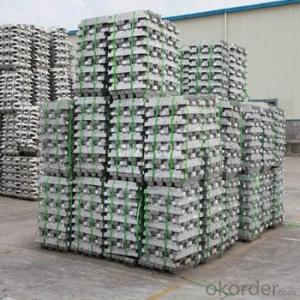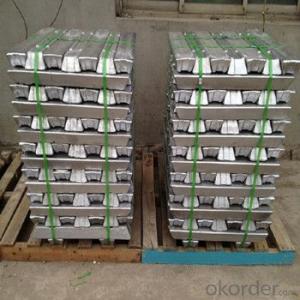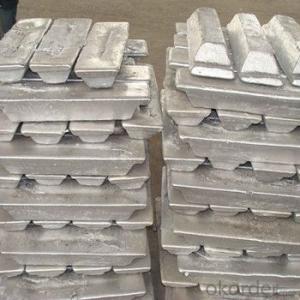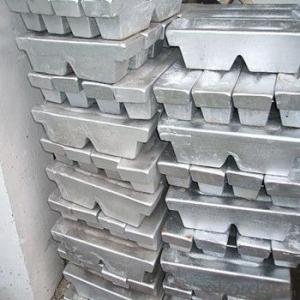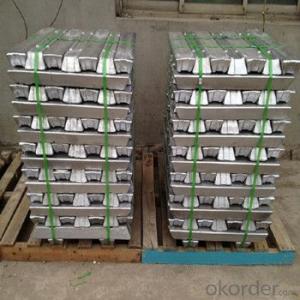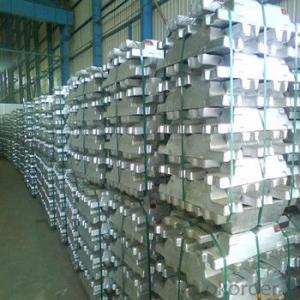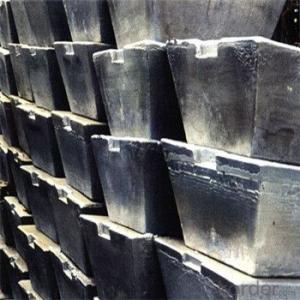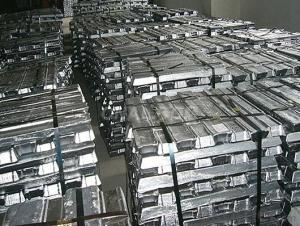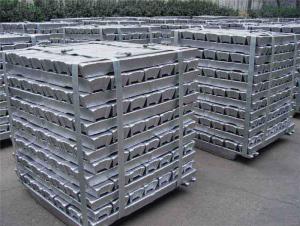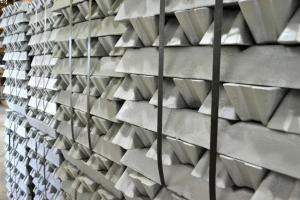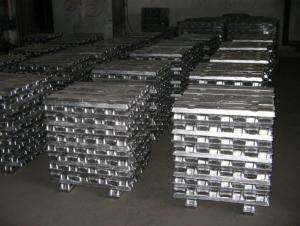Aluminium Ingot With High Grade 99.7% For Hot Sale
- Loading Port:
- China main port
- Payment Terms:
- TT OR LC
- Min Order Qty:
- 1000 m.t
- Supply Capability:
- 10000 m.t/month
OKorder Service Pledge
OKorder Financial Service
You Might Also Like
Pure Aluminum Ingot Used for Industry
1.Structure of Aluminum Ingot Description
An ingot is a piece of material, usually metal, that is cast into a shape suitable for further processing. Insteelmaking, it is the first step among semi-finished casting products. Ingots usually require a second procedure of shaping, such as cold/hot working, cutting, or milling to produce a useful final product. Non-metallic and semiconductor materials prepared in bulk form may also be referred to as ingots, particularly when cast by mold based methods.
2.Main Features of the Aluminum Ingot
•High Purity
•High strength
•Fast melting
•Best price
•Good after-service
3. Aluminum Ingot Images
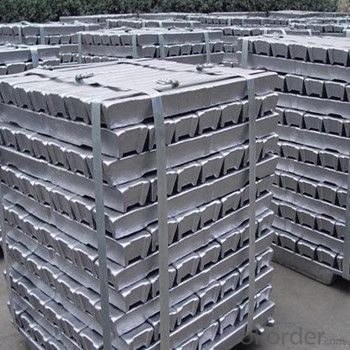
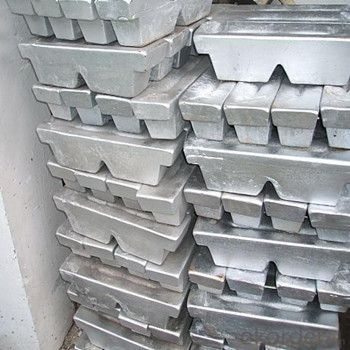
4. Aluminum Ingot Specification
Grade | Chemical Composition % | |||||||||
Al≥ | impurities ≤ | |||||||||
Si | Fe | Cu | Ga | Mg | Zn | Mn | others | Sum | ||
Al99.9 | 99.90 | 0.50 | 0.07 | 0.005 | 0.02 | 0.01 | 0.025 | - | 0.010 | 0.10 |
Al99.85 | 99.85 | 0.80 | 0.12 | 0.005 | 0.03 | 0.02 | 0.030 | - | 0.015 | 0.15 |
Al99.7 | 99.70 | 0.10 | 0.20 | 0.010 | 0.03 | 0.02 | 0.030 | - | 0.030 | 0.30 |
Al99.6 | 99.60 | 0.16 | 0.25 | 0.010 | 0.03 | 0.03 | 0.030 | - | 0.030 | 0.40 |
Al99.5 | 99.50 | 0.22 | 0.30 | 0.020 | 0.03 | 0.05 | 0.050 | - | 0.030 | 0.50 |
Al99.00 | 99.00 | 0.42 | 0.50 | 0.020 | 0.03 | 0.05 | 0.050 | - | 0.050 | 1.00 |
5.FAQ of Aluminum Ingot
We have organized several common questions for our clients,may help you sincerely:
①How about your company?
A world class manufacturer & supplier of castings forging in carbon steel and alloy steel,is one of the large-scale professional investment casting production bases in China,consisting of both casting foundry forging and machining factory. Annually more than 8000 tons Precision casting and forging parts are exported to markets in Europe,America and Japan. OEM casting and forging service available according to customer’s requirements.
②How to guarantee the quality of the products?
We have established the international advanced quality management system,every link from raw material to final product we have strict quality test;We resolutely put an end to unqualified products flowing into the market. At the same time, we will provide necessary follow-up service assurance.
③How long can we receive the product after purchase?
In the purchase of product within three working days, We will arrange the factory delivery as soon as possible. The pecific time of receiving is related to the state and position of customers.Commonly 7 to 10 working days can be served.
- Q: How much is the price of the common aluminum sheet on the basis of the aluminum ingot? How much is the price of the broken aluminum alloy profile on the basis of the aluminum ingot?
- Ordinary aluminum cold rolling is about 2 or more thousand, hot rolling plus more than 3 thousand. Regular is within 4 meters long, 0.9-1.3 meters wide, more than 0.2 millimeters thick, special specifications but also additional money.If the section is too large, it's hard to say.
- Q: What are the advantages of using aluminum ingots in the production of medical devices?
- There are several advantages of using aluminum ingots in the production of medical devices. Firstly, aluminum is a lightweight metal, making it ideal for medical devices that need to be portable and easy to handle. It reduces the overall weight of the device, making it more comfortable for patients and easier for healthcare professionals to use. Secondly, aluminum has excellent corrosion resistance properties. This is crucial in medical devices as they often come into contact with various bodily fluids and chemicals. By using aluminum ingots, manufacturers can ensure that the medical devices will not corrode or degrade over time, thus increasing their lifespan and reliability. Additionally, aluminum is highly malleable and can be easily shaped and formed into intricate designs. This allows for the production of complex medical devices with precise specifications. The versatility of aluminum ingots enables the creation of devices that can fit various anatomical structures, ensuring a better fit and improved functionality for patients. Furthermore, aluminum is a non-toxic material and does not react with human tissues. It is biocompatible, meaning it can be safely used in medical devices that come into direct contact with the body, such as implants, surgical instruments, and prosthetics. Aluminum's biocompatibility reduces the risk of adverse reactions or complications for patients. Lastly, aluminum ingots are cost-effective compared to other metals commonly used in medical device production. The abundance of aluminum ore and its relatively low cost of extraction make it a more affordable option for manufacturers. This cost-effectiveness can lead to more accessible medical devices, benefiting patients and healthcare systems worldwide. In conclusion, the advantages of using aluminum ingots in the production of medical devices include their lightweight nature, excellent corrosion resistance, malleability, biocompatibility, and cost-effectiveness. These properties make aluminum a suitable choice for creating high-quality, durable, and safe medical devices.
- Q: What are the common defects found in aluminum ingots?
- Aluminum ingots may exhibit several common defects. Porosity is one such defect, characterized by the presence of small voids or air pockets within the ingot. It can arise from improper casting techniques or insufficient degassing of the molten aluminum. Porosity weakens the overall structure of the ingot and diminishes its mechanical properties. Another defect frequently observed is segregation, which arises when alloying elements or impurities are unevenly distributed within the ingot. This leads to variations in composition and properties across different sections of the ingot. Segregation can be caused by improper alloying or inadequate mixing of the molten aluminum. Cracking is yet another defect often encountered in aluminum ingots. It may occur during cooling or solidification if there is rapid or uneven cooling, resulting in thermal stress and cracking. Excessive hydrogen content in the aluminum can also induce cracking by promoting the formation of internal cracks. Furthermore, surface defects, including dross, oxide films, and inclusions, are commonly found in aluminum ingots. Dross refers to impurities and oxides that float on the surface of the molten aluminum and become trapped in the ingot during solidification. Oxide films form on the ingot's surface due to exposure to air or inadequate protection during casting. Inclusions are foreign particles or non-metallic compounds that get trapped within the ingot during solidification. These defects significantly impact the quality and performance of aluminum ingots. Consequently, it is critical to employ appropriate casting techniques, control alloy composition, ensure sufficient degassing, and implement effective quality control measures to minimize the occurrence of these defects.
- Q: Can you melt the aluminium ingot?
- When the aluminum alloy coil is punched out of each wafer, there will be a lot of geometric waste, the manufacturer will carefully recycle, and then continue to be used to produce tank material after remelting.
- Q: What is the difference between aluminium ingot YL112 and YLD112?
- YL102 is the only major alloy element that can be cast. It is a silicon second aluminum alloy with a silicon content of 10.0~13.0%,
- Q: How are aluminum ingots used in the production of cookware?
- Aluminum ingots play a crucial role in the production of cookware due to their unique properties. These ingots are melted down and then shaped into desired cookware forms, such as pots, pans, and baking sheets. One of the main reasons aluminum is widely used in cookware production is its excellent heat conductivity. Aluminum conducts heat more efficiently than other metals, which ensures even heat distribution across the entire surface of the cookware. This property allows for consistent cooking results, preventing hotspots and reducing the risk of food burning or sticking to the pan. Moreover, aluminum is lightweight and easy to handle, making it a popular choice for cookware. This feature is particularly beneficial for individuals with limited strength or mobility, as it enables them to maneuver and lift the cookware without much effort. However, pure aluminum is relatively soft and susceptible to scratches and dents. To improve its durability, aluminum ingots are often alloyed with other metals, such as copper or stainless steel, during the cookware manufacturing process. These alloys enhance the strength and hardness of the cookware while retaining the excellent heat conductivity of aluminum. Additionally, aluminum is non-reactive, meaning it does not interact with acidic or alkaline foods. This characteristic ensures that the taste and quality of the cooked food are not affected by the cookware material. Furthermore, aluminum cookware is generally affordable, making it accessible to a wide range of consumers. Its cost-effectiveness, combined with its excellent cooking performance, has made aluminum cookware a staple in many kitchens around the world. In conclusion, aluminum ingots are indispensable in the production of cookware due to their excellent heat conductivity, lightweight nature, and non-reactive properties. By utilizing aluminum ingots, manufacturers can create cookware that provides even heat distribution, durability, and affordability to enhance the cooking experience for consumers.
- Q: Pop can recovery aluminium ingot
- This equipment is like a house to buy equipment and then to their masonry, generally dug a hole 2 meters deep, the pot material has 2 kinds, one kind is graphite, a cast iron, graphite is relatively better, Zhejiang has Yongkang sell, including tools, and this process is originated in the then, if you want to do better to the study, to be able to please the master.
- Q: What is the difference between a aluminium ingot with and without a ticket?
- Yes.Do not include tickets, usually less than 3 to 4 points!
- Q: How are aluminum ingots used in the aerospace industry?
- Aluminum ingots are commonly used in the aerospace industry due to their lightweight and high strength properties. They are used to manufacture various components such as aircraft frames, wings, and engine parts. These ingots are melted and cast into desired shapes to create strong and durable structures for aircraft, ensuring optimal performance and fuel efficiency.
- Q: What are the health risks associated with working with aluminum ingots?
- Certain health risks can be associated with working with aluminum ingots due to the potential exposure to various hazards. The following are some health risks that are commonly associated with working with aluminum ingots: 1. Inhaling aluminum particles: There is a risk of inhaling fine aluminum particles during the handling and processing of aluminum ingots. Prolonged exposure to aluminum dust or fumes can lead to respiratory problems such as bronchitis, pulmonary fibrosis, or even lung cancer. 2. Irritation of the skin and eyes: Direct contact with aluminum ingots or its dust can cause skin irritation, redness, and rashes. It may also cause eye irritation, resulting in redness, itching, or a burning sensation. 3. Potential neurological effects: Chronic exposure to aluminum, especially through inhalation or ingestion, has been linked to possible neurological effects. Although the exact mechanisms are not fully understood, there is some evidence suggesting a connection between aluminum exposure and the development or progression of neurodegenerative diseases, such as Alzheimer's disease. 4. Occupational asthma: Exposure to aluminum dust or fumes can trigger or worsen asthma symptoms in individuals who are already prone to respiratory conditions. This can lead to difficulties in breathing, wheezing, coughing, and chest tightness. 5. Heavy metal toxicity: Aluminum is classified as a heavy metal, and excessive exposure can result in heavy metal toxicity. Symptoms of aluminum toxicity may include gastrointestinal issues, bone pain, muscle weakness, and potential damage to the nervous system. To minimize these health risks, it is crucial to implement appropriate safety measures and adhere to proper protocols when working with aluminum ingots. This includes wearing personal protective equipment (PPE) such as gloves, goggles, and respiratory masks, ensuring adequate ventilation in the workplace, and regularly cleaning to reduce the accumulation of aluminum dust. Additionally, individuals working with aluminum ingots are advised to undergo regular medical check-ups and monitoring to detect any potential health issues at an early stage.
Send your message to us
Aluminium Ingot With High Grade 99.7% For Hot Sale
- Loading Port:
- China main port
- Payment Terms:
- TT OR LC
- Min Order Qty:
- 1000 m.t
- Supply Capability:
- 10000 m.t/month
OKorder Service Pledge
OKorder Financial Service
Similar products
Hot products
Hot Searches
Related keywords




